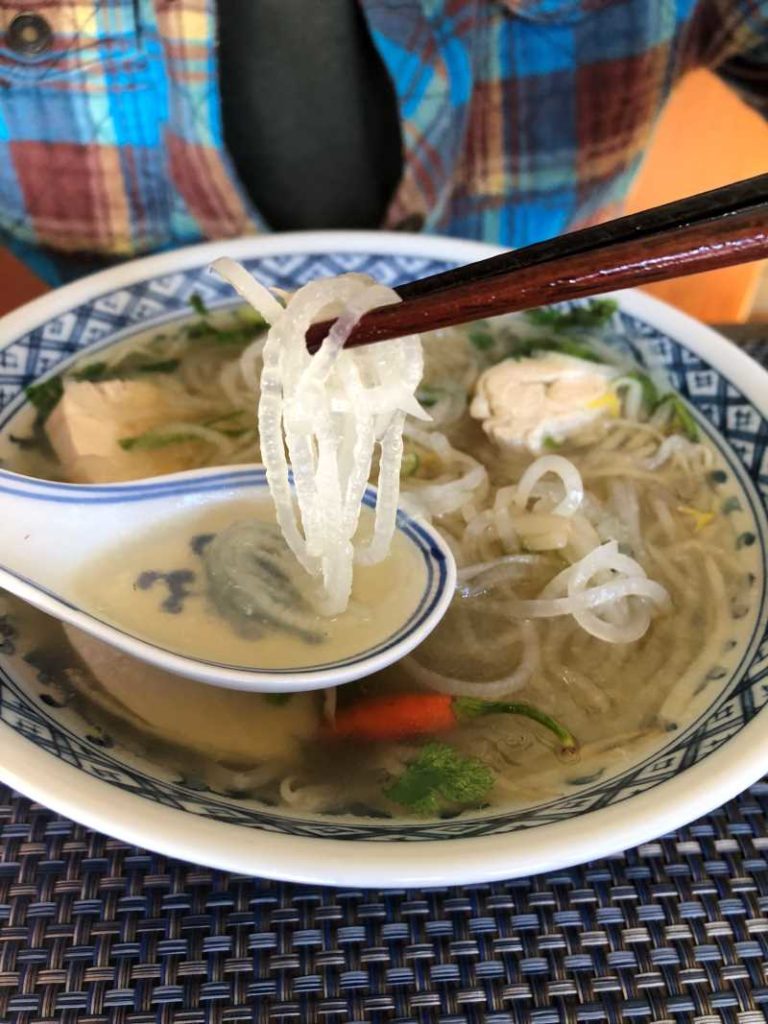
The noodles in the above bowl of pho are not rice noodles. They’re made from daikon. They are "doodles". Like many things in life, pho has a dual meaning. In Vietnamese, the term pho means both the warming spiced noodle soup as well as the flat wide noodles that go into the bowl. Bánh phở are what the noodles are called in Vietnamese. On pho menus, there are pho noodle soup options as well as dishes like pan-fried or stir-fried pho noodles. However, despite that close relationship between the dish and ingredient, people ponder the possibility of omitting or cutting back on the noodles, mostly out of concern for eating too many carbohydrates. In Vietnamese, starchy foods like noodles and rice are categorized as bột. Nowadays, when food is relatively more plentiful than before, people in and outside of Vietnam are concerned about eating too many starchy foods.
How hard is it to have a bowl of pho without the noodles? Is it still pho if you don’t include pho noodles? The answers are low-carb pho is doable and yes, you can still have pho without pho noodles. You have options for low-carb pho but know what you’re gaining and losing.
What rice noodles do for pho soup
As I wrote in The Pho Cookbook, bánh phở rice noodles carry and convey the flavors of pho broth. The narrow strands of flat rice noodles are neutral and absorb just enough of the hot broth so you taste it on the noodles as well as when you slurp up the broth. Without the noodles, the broth can be an overly intense soup. At restaurants you can order pho without noodles.
When I was growing up, we’d eat leftover pho broth with bits of the cooked beef and rau ram (Vietnamese coriander) and squeezes of lime juice. We always diluted the broth a bit with water. It was a terrific light soup for dinner. In The Pho Cookbook, there’s a recipe called xao xuong bo (page 70) that involves serving the broth with the soup bones and slices of cooked beef. No noodles are involved but I do offer the option of adding fried Chinese donuts on the side! Diners dig out the marrow and carve off the tendon.
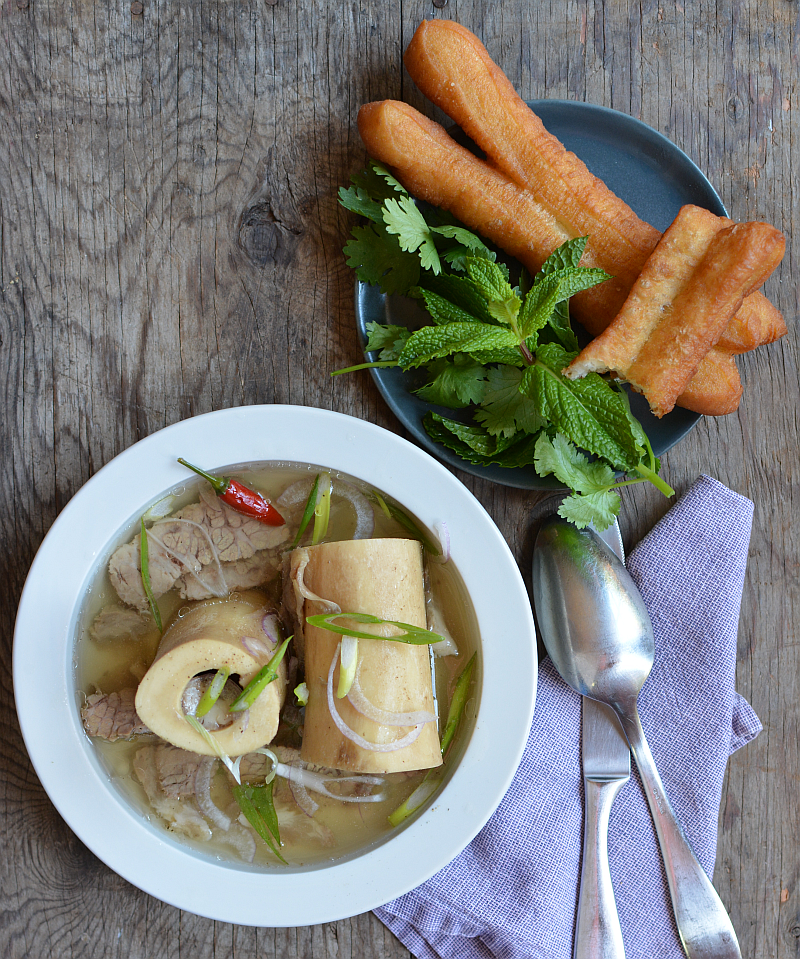
It’s Flintstones-ish and fun. I’ve paid good money to eat such a dish at a hipsterish restaurant in Las Vegas. All that said, in carrying and conveying the flavor of pho, squiggly, chewy tender noodles also add texture. The noodles help to define the pho experience. So what can you do to mimic that experience without going whole hog with noodles?
Low-noodle Pho
One option is to replace the rice noodles with blanched bean sprouts. If you boil the noodles, at the last minute, add a bunch of bean sprouts (2 or 3 handfuls per serving). Once the bean sprouts just soften, drain the noodles and sprouts. Then rinse off the starch and assemble your bowls. The bean sprouts aren’t exactly like pho noodles but the shape and width of the sprouts match that of the noodles well. The below photos include the blanched bean sprouts with rice noodles or with daikon noodles.
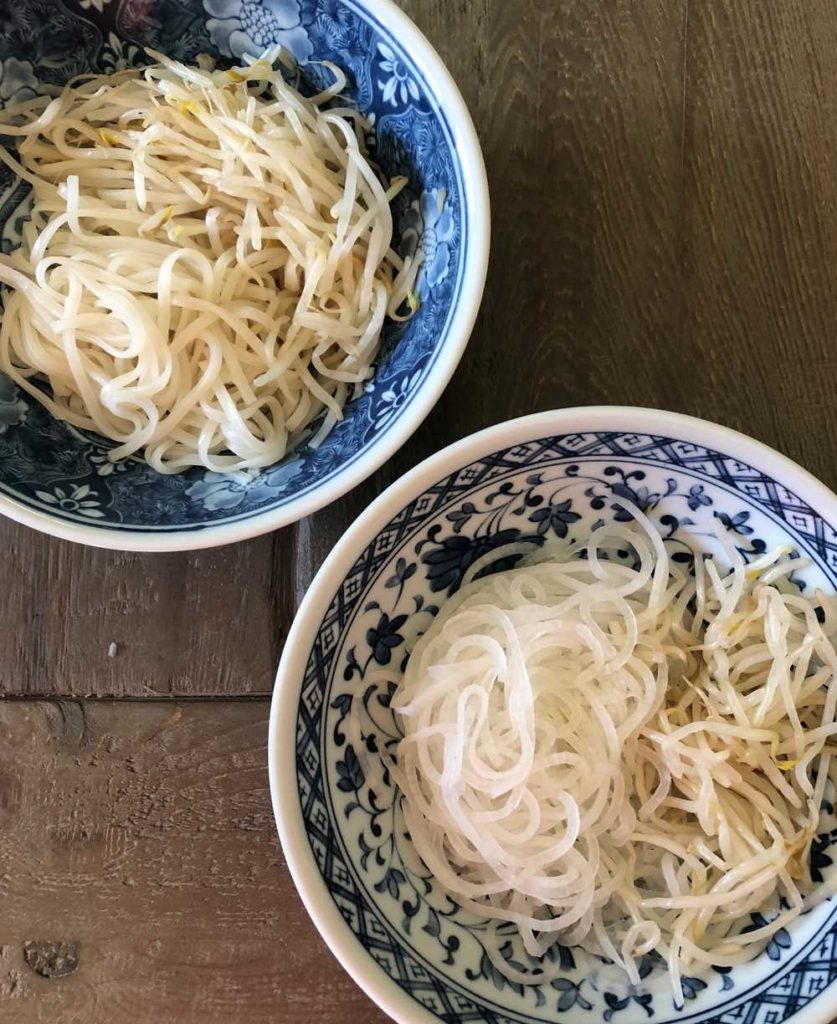
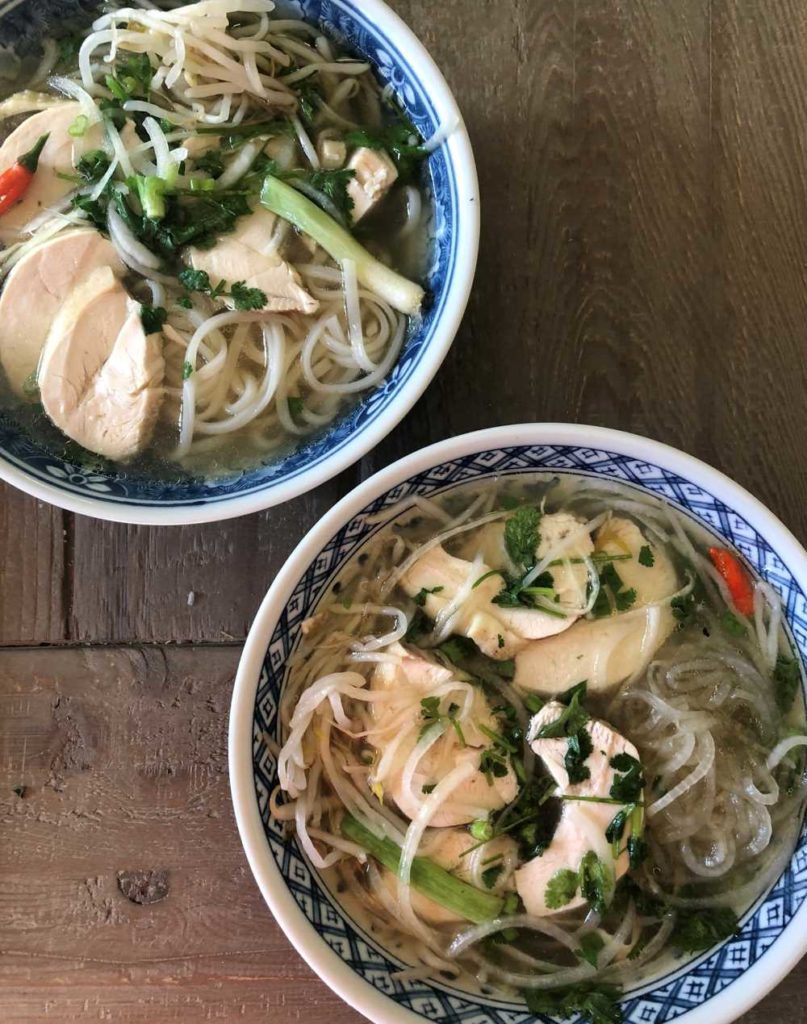
Pho with Shirataki Noodle
Replace the rice noodles with shirataki noodles, which offer a chewy texture, white color and come in a flat noodle-like strand to mimic pho noodles. You don’t need a ton of shirataki noodles like you would rice noodles. That’s because they make you feel very full. For me, there’s a fair amount of chewing involved with eating shirataki noodles so I kinda tire out! The noodles are made from mostly water plus a small amount of konjac (elephant yam). They’re low calorie, low-carb, flavorless and friendly for many diets. They’re a little pricey, though.
Pho with Spiralized Noodles
Another low-carb pho option is to go with spiralized vegetables – either fully or partially replacing the regular rice noodles. If you do a partial replacement, go with a 50/50 or 60/40 combination of rice noodles and spiralized vegetable noodles. What kind of vegetables to use? I like zucchini noodles ("zoodles") and daikon noodles ("doodles"). The zucchini noodles are pretty with a jade color. The daikon noodles are white so they look like rice noodles; daikon can be a little gassy, though. With spiralized vegetable noodles in pho, you get to load up on extra fiber for a super healthy bowl of pho noodle soup. Daikon noodle pho (doodle pho) and zucchini noodle pho (zoodle pho) are light yet satisfying, I've found.
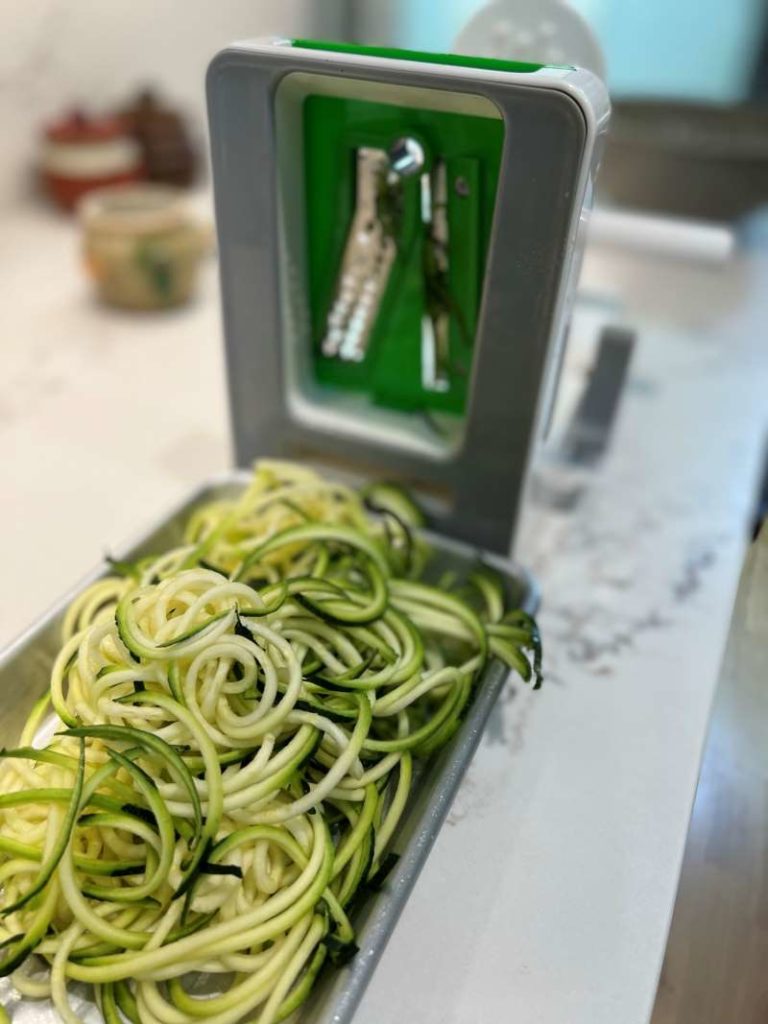
How to make vegetable noodles for low-carb pho
Make sure to buy zucchini or daikon that's at least 1 ½ inches wide. I aim for ones that are relatively straight. A few pointers:
- How much vegetables to use? For four bowls of zoodle pho or doodle pho, buy 2 ½ pounds of zucchini or 2 pounds of daikon radish.
- How to prep the vegetables? Trim the ends then peel the daikon but do not peel the zucchini.
- Which spiralizer works well? I use the OXO spiralizer. It sits securely and cuts beautifully, as you'll see in the video below. (To make the umami garlic daikon noodles in the video, go to this recipe.)
Because zucchini and daikon both can introduce flavor to a well constructed pho broth and knock it off balance, parboil the zoodles or doodles then assemble them as regular pho bowls, with or without rice noodles. I favor parboiling when I’m also blanching bean sprouts and/or boiling rice noodles. There’s a pot of hot water already being used. If a pot of hot water isn’t convenient, I toss the noodles with salt, massage the noodles or let them sit for about 10 minutes until they’re wet from releasing liquid. Then I rinse the noodles well and add them to the pho broth briefly to warm up and absorb some pho-ish flavor before dishing up into the bowls for pho. Here's how the zoodles look after salting:
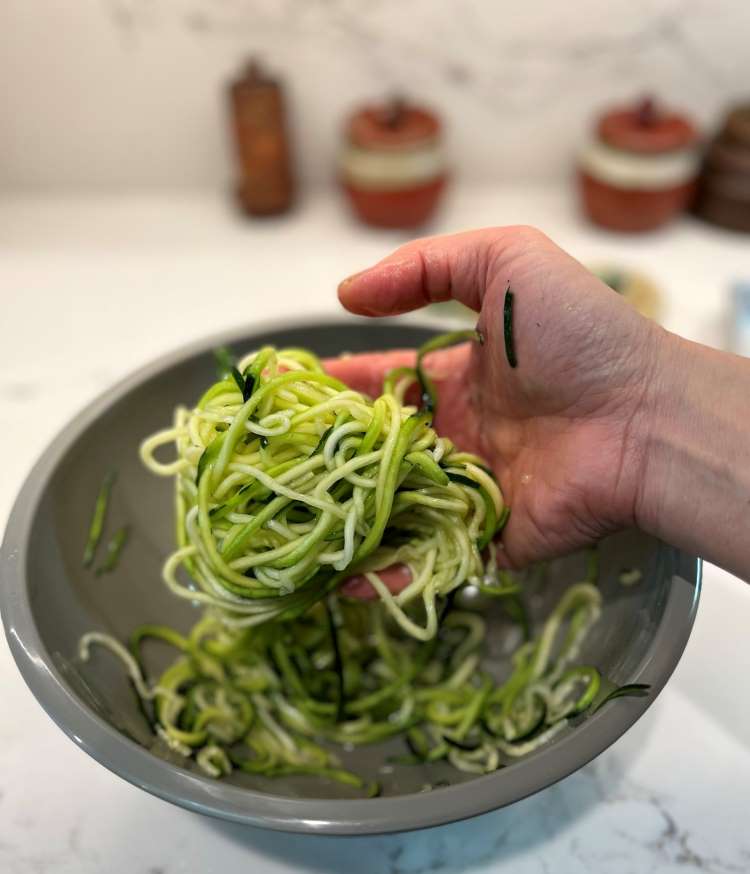
And below are beef pho with a 50/50 rice noodle and zoodle combo plus a 75/25 combo of zoodles and bean sprouts. I always have extra blanched bean sprouts on the table, just in case. Pho is a relatively healthy dish but if you add extra vegetables, it's even healthier.
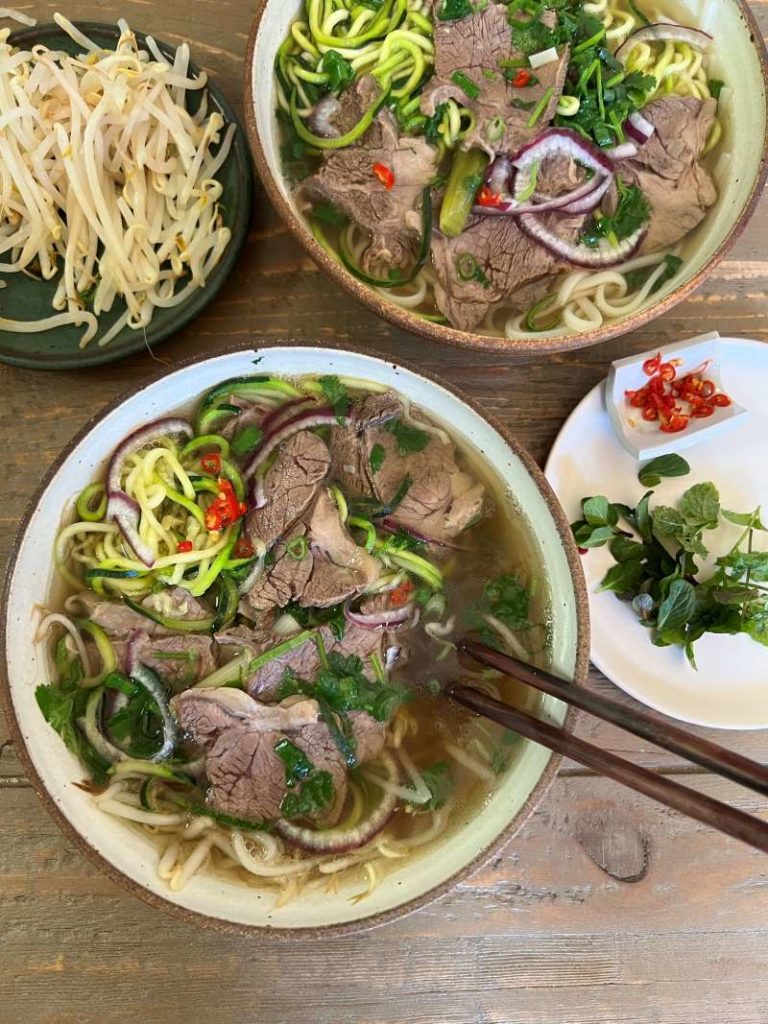
DIY Pho Recipe Tips
- Which vegetable goes with which pho? I've only tried the zoodles and doodles with chicken and beef pho. The spiralized veggies are relatively neutral so I'm thinking that you could use the above techniques on any kind of pho, from vegetable and seafood to chicken, beef, and lamb.
- And if you're needing more tips, head to this mega pho page. There are nuggets of information and inspiration, from blending spices and sourcing bones to making instant pot chicken pho.
Have a pho-nomenal time!

















Frank Mosher says
Thank you for your insight on how to lower carbs when making Pho. I have on of those Spirilaziers also, have yet to use it, I knew about Zuccinni but not about Daikon which I really like. Thank you! I don't know if you are aware or not, but there is root vegetable "Konjac" either produced in Japan or China. It is available in most pasta shapes, even "rice" and is very high in fibre, and very low in carbs. You may know of it! Cheers!
Andrea Nguyen says
Yes! Konjac is included above in the Shirataki noodle discussion. It's a crazy noodle/rice option. Thanks for weighing in, Frank!
Lan Nguyen says
Sorry alo the kind of noodles you talking aren't wong for Phở. Ì you want to bè healthy thật funeral but do not change the the original authentic of "VIETNAMESE Phở ".the recipe you put out all wrong .so please if you don't know how to eat or cook phở you should learn and ask professional who cook and had this recipe for years.
Andrea Nguyen says
People have options. On this site, I've written about how banh pho is made in Vietnam: https://www.vietworldkitchen.com/blog/2017/03/how-pho-rice-noodles-are-made.html
Also, there's a handy post on how to buy dry and fresh banh pho too: https://www.vietworldkitchen.com/blog/2010/03/vietnamese-noodles-101-banh-pho-flat-rice-noodles.html
This low-carb approach is for folks who want an alternative. Note that I suggest combining banh pho with the vegetable noodles.
Erica says
Actually, Andrea Nguyen IS a PROFESSIONAL cook. A professional VIETNAMESE cook even.
And, apparently, a professional respectful responder to criticism.
Dai says
I used "Healthy Noodle", available at Costco, as banh pho replacement. It's pretty good.
Andrea Nguyen says
Thanks for the tip, Dai!
Vinnie says
Use pork skin from the Asian store. Looks just like the rice noodles. No carbs at all.
Andrea Nguyen says
Oh, you're quite clever! Frozen shredded pork skin. It's rather fine, though, don't you think? Thanks for the idea.